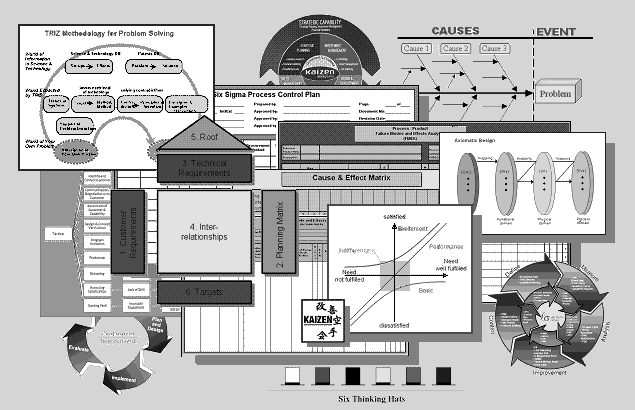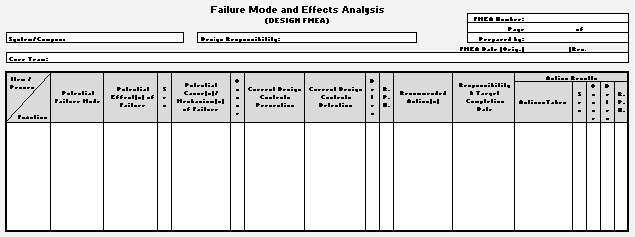|
Key Method Search
Analysis of the products problems proved that most of those
problems are design related. Product quality,
simplicity and robustness of tooling, feasibility of manufacturing,
ease of assembly, product distribution,
installation, operational use, service and recycling are
strongly affected by design.
Conveying unknown design errors through the entire process
of the product development till full production
is like driving defective car without knowing what is
wrong. Results of driving that car can be insignificant
or disastrous for a driver. Similarly, unknown and unsolved
design errors may create no problems or can be
severe for the company as well.
Any incorrectly designed detail can create functional problems
and may reduce quality of the final product.
Therefore all design related problems have to be detected
and eliminated before the final design is released.
For that purpose the product development teams should
have effective technique for all types of design
faults indication and should have a tool to eliminate
those flaws by applying proper design solutions.
The final design ought to be free from errors.
There are many specialized tools created for different
areas of the product development and for designing
of different features of the products. Various techniques
exist for the product problems solving as well.
Design recommendations exist for development of the specific
details or functions of the product.
Each
of those
product development methods has own specific purpose.
More then 120 product development related methods had been
reviewed by author with expectation to find
the Ideal method for the product design quality perfecting,
and 48 of them had been studied and examined
for their features as the engineering tools for the design
errors detection and elimination.
Those
selected methods included: DFMEA, DFM&A, QFD, VA/VE,
Best Practices, Robust Design, DOE,
Design
for Six Sigma, Design for Reliability, Axiomatic Design,
Mistake-Proofing, Lessons Learned,
8D Problem
Solving, Fishbone, Brainstorming, TRIZ, various creativity
techniques and others.

Those methods had been analyzed for the design related
features, including evaluation of their basic abilities
with the four following questions:
1 -
If the method can be used “as is” to indicate design related
problems at any stage of product development?
2 - What is certainty that the method can indicate all design
errors and design related problems?
3 - If the method “as is” can provide solutions for all
indicated problems?
4 -
How easy is to use the selected method (its simplicity and
time required for the design examination)
One
of the first evaluations had been made for the DFMEA that
is widely known method required in the
automotive
industry by APQP system. DFMEA (Design Failure Mode and
Effects Analysis) is an analytical
technique
that assesses the probability of failure as well as the
effect of such failure.
The
purpose of DFMEA is to identify the potential failures and
the related risks designed into a product
and
take steps to minimize that risk and prevent possible damages.
Review
of the DFMEA with the prepared questionnaire resulted in
the following answers:
1 -
If the method “as is” can indicate design errors?
- - The DFMEA document is a
blank table and it does not detect design problems by itself.
- - DFMEA table must be filled
with information before it can be used.
2 -
What is certainty of all design errors indication with the
method?
- - Value of the DFMEA depends
on quantity and quality of information entered to the table.
DFMEA is
-
- usually
prepared by team of designers and engineers based on their
experience and collected information.
-
- Certainty
for all design errors indication in DFMEA relates to the
knowledge and imagination of the team.
-
-
3 - If the method “as is” can provide solutions for the
indicated problems?
-
- The
DFMEA document is a blank table and it does not provide
design solutions by itself.
-
- DFMEA
table must be filled with information before it can be used
for reading the design solutions.
-
- DFMEA
is the method of collecting information where Info Output
equals to Info Input.
4 -
Ease of the method use;
.
- DFMEA
has a structure with 17 information columns, where essentials
needed for the product design
- - evaluation and the correct
design development are contained on four columns only;
- - -- Failure mode -- Effects
-- Cause of the failure -- Recommended Actions.
-
- The
DFMEA method is quite complex with extensive manual. Preparing
DFMEA is
time consuming, since
-
- collecting
information for that document can take from tens to hundreds
of hours.\

DFMEA
evaluation summary:
Value of DFMEA depends on quantity and quality of information
entered to the FMEA table, therefore
if
any incorrectly designed detail is missed on DFMEA or if
any recommended solution has uncertainty
then
the DFMEA may not prevent the product failure.
Experience
reveals that most of DFMEA documents include only fraction
of all potentially possible errors
and
DFMEA users focus mostly on the problems with the highest
Risk Priority Numbers, but for achieving
excellent
quality of the product the all errors should be eliminated
from design regardless their RPN.
---------------------------------------------------------------------------------------------------------------------------------------------
Conclusion
Each
of the existing methods, systems and techniques listed above
had been checked with four questions
for
their basic abilities and later evaluated for their other
features, resulting in following conclusion:
The analyzed methods are just different ways of collecting
specific information, or are different ways of
operating with the collected knowledge. Those methods do
not replace knowledge.
Most
of those methods are the problem solving techniques that
can be used for already indicated problems.
They
recommend various problem solving processes as a replacement
for the insufficient knowledge or
inadequate
understanding of the problem. There are methods for creativity
stimulation as well, but there
is a
lack of the
effective methods for
the problems detection
and problems solving that are independent to
the
memorized knowledge
of the
individual
person. Furthermore, experience indicates that effectiveness
of the errors detection process is reversely proportional
to its reliance on the person's memory.
Available
knowledge is the base of effectiveness of most analyzed
methods and those methods are as
good
as good is knowledge presently accessible to users of those
methods. Since none of the existing
methods
has ability to detect all types of design errors, therefore
some design errors can be unknown to
the
product
development
team and as Six Sigma highlights: - "We will not improve
what we do not know" -
---------------------------------------------------------------------------------------------------------------------------------------------
Idea
Usually,
it is beneficial to analyze solutions of similar problems
on other fields in order to revise own point
of view,
to modify approach to the existing problem or to challenge
tradition or standards with a new and
different
way of thinking and finally to adapt the ready to use solution
from the other field.
For
example:
Error
detection is used by the computer word processing programs.
Word processors have spell checkers
formed
as the universal program for any document written. Spell-checker
uses own library of words. When
text
is typed then each word is compared to the words from library.
If particular sequence of
typed
letters
does
not
exist in a library then it is highlighted as potential error.
Library
works as the master of correctness.
The next and very useful function of the spell-checker
is suggesting the correct word. If configuration of
letters of an incorrectly typed text is similar to some
words in the master library then those words are listed
as recommendations for replacement.
We
expect that one and always ready to use spell-checker
"knows
everything" and can detect all types
of errors
with ability to provide the correct suggestions as well.
Checking of the text can be performed
by
a single person and no consulting and no team meetings are
needed for the text spelling evaluation.
Very
similar approach can be used for the design errors checking.
Instead
of having separate detection methods for different groups
of design errors or for different types of
features
it may be more practical to have a single and universal
design evaluation system that would work
for
all
designs
with ability to recommend optimal solutions for all detected
design errors.
Additionally, it would be good if the design evaluation
can be performed just by a single engineer.
|

